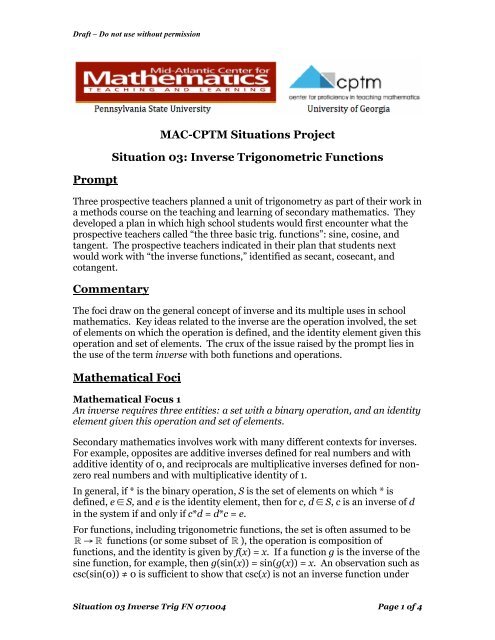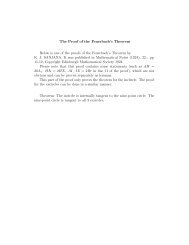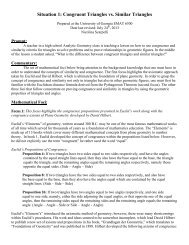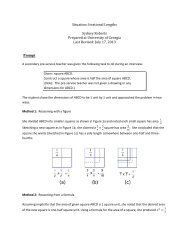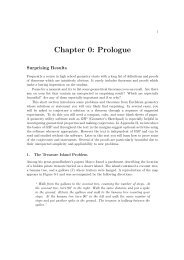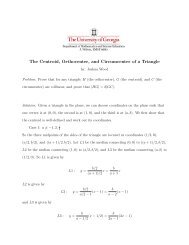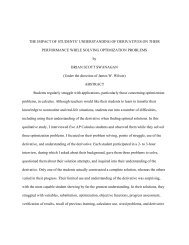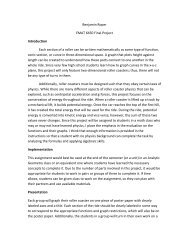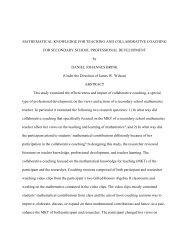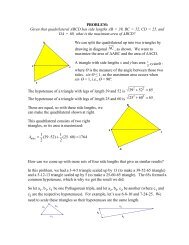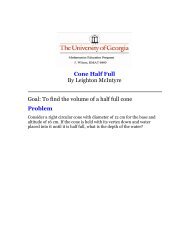Situation 03: Inverse Trigonometric Functions
Situation 03: Inverse Trigonometric Functions
Situation 03: Inverse Trigonometric Functions
You also want an ePaper? Increase the reach of your titles
YUMPU automatically turns print PDFs into web optimized ePapers that Google loves.
Draft – Do not use without permissionPromptMAC-CPTM <strong>Situation</strong>s Project<strong>Situation</strong> <strong>03</strong>: <strong>Inverse</strong> <strong>Trigonometric</strong> <strong>Functions</strong>Three prospective teachers planned a unit of trigonometry as part of their work ina methods course on the teaching and learning of secondary mathematics. Theydeveloped a plan in which high school students would first encounter what theprospective teachers called “the three basic trig. functions”: sine, cosine, andtangent. The prospective teachers indicated in their plan that students nextwould work with “the inverse functions,” identified as secant, cosecant, andcotangent.CommentaryThe foci draw on the general concept of inverse and its multiple uses in schoolmathematics. Key ideas related to the inverse are the operation involved, the setof elements on which the operation is defined, and the identity element given thisoperation and set of elements. The crux of the issue raised by the prompt lies inthe use of the term inverse with both functions and operations.Mathematical FociMathematical Focus 1An inverse requires three entities: a set with a binary operation, and an identityelement given this operation and set of elements.Secondary mathematics involves work with many different contexts for inverses.For example, opposites are additive inverses defined for real numbers and withadditive identity of 0, and reciprocals are multiplicative inverses defined for nonzeroreal numbers and with multiplicative identity of 1.In general, if * is the binary operation, S is the set of elements on which * isdefined, e ∈ S, and e is the identity element, then for c, d ∈ S, c is an inverse of din the system if and only if c*d = d*c = e.For functions, including trigonometric functions, the set is often assumed to befunctions (or some subset of ), the operation is composition offunctions, and the identity is given by f(x) = x. If a function g is the inverse of thesine function, for example, then g(sin(x)) = sin(g(x)) = x. An observation such ascsc(sin(0)) ≠ 0 is sufficient to show that csc(x) is not an inverse function under<strong>Situation</strong> <strong>03</strong> <strong>Inverse</strong> Trig FN 071004 Page 1 of 4
Draft – Do not use without permissioncomposition for sin(x). If the operation is multiplication and the set is realnumbers, in contrast, the multiplicative identity is 1, and for any value of x suchthat sin(x) ≠ 0, the number csc(x) is the multiplicative inverse for the numbersin(x).More generally, the functions and are inverses if and only ifg consists of the ordered pairs (f(s), s) and f consists of the ordered pairs (g(t), t).Support for that conclusion comes from consideration of issues of domain andrange. In order for f and g to be inverse functions, and .Note that in this case, the identity ‘entity’ actually consists of an identity functionon T and an identity function on S. When the domain and range are copies of thesame set, the two identities will be equivalent.For the functions f and g above, the range of f must be the domain of g, and therange of g must be the domain of f. For example, the domain of sine is the set ofall real numbers, but because the range of cosecant is not all real numbers,cosecant and sine are not inverse functions.Mathematical Focus 2Although the inverse under multiplication is not the same as the inverse underfunction composition, the same notation, the superscript -1, is used for both.The general function notation, y = f(x), means that y is the image of x under thefunction f. To indicate the inverse function, the notation x = f -1 (y) is used; itmeans that x is the image of y under the inverse of f. The superscript -1 is used toshow that the inverse f -1 is a function related to f; the superscript is not to beinterpreted as an exponent. In contrast, means that z is the product of xand y, and to indicate the inverse of the product, the notation x = zy -1 is used,where the superscript is interpreted as an exponent. These two usages of thesuperscript -1 are distinct in that one represents a function inverse and the otheris usually thought of as an exponent that happens to yield the multiplicativeinverse.The functions secant, cosecant, and cotangent are defined, respectively, asfollows: , , and . They are not definedfor cos (x) = 0, sin (x) = 0, or tan (x) = 0. They are written using exponents as sec(x) ≅ (cos (x)) -1 , csc (x) ≅ (sin (x)) -1 , and cot (x) ≅ (tan (x)) -1 .In contrast, the inverse functions of sine, cosine, and tangent are, respectively,(sometimes written arcsin (x)), (sometimes written arccos (x)),and(sometimes written arctan (x) or arctg (x)).These inverse trigonometric functions are multi-valued in the sense that there aremultiple values of x such that y = sin (x), so is not uniquely defined and is<strong>Situation</strong> <strong>03</strong> <strong>Inverse</strong> Trig FN 071004 Page 2 of 4
Draft – Do not use without permissiontherefore not a function unless a principal value is defined by restricting thedomain of y = sin (x). Restricting y = sin (x) to with yieldsan inverse sine function with and . Principal values aresometimes denoted with a capital letter; for example, the principal value of theinverse sine, , may be denoted or Arcsin (x) (but thiscapitalization notation is far from universal and may, in fact, be used with theopposite meaning).Mathematical Focus 3When functions are graphed in an xy-coordinate system with y as a function ofx, these graphs are reflections of their inverses’ graphs (under composition) inthe line y = x.The graph of a function reflected in the line y = x is the graph of its inversefunction, though without restricting to principal values, the inverse may not be afunction. Justifying this claim requires establishing that the reflection of anarbitrary point (a, b) in the line y = x is the point (b, a).The following argument shows that the reflection of an arbitrary point (a, b) inthe line y = x is the point (b, a), using the geometric properties of reflection (thepoint is a reflection of the point in line l if and only if l is the perpendicularbisector of ). First, we note that the perpendicular bisector of consists ofprecisely those points in the plane that are equidistant from and . So, wechoose an arbitrary point on the line , say . Using the distance formulato compute the distance between and and between andwe find that and so the line is theperpendicular bisector of the line segment between and . Therefore,the reflection of the point in the line is .Suppose that cosecant and sine were inverse functions. Then, a reflection of thegraph of y = csc(x) in the line y = x would be the graphof y = sin(x). The figure at the right shows, on onecoordinate system, graphs of the sine function, the linegiven by y = x, the cosecant function, and thereflection of the cosecant function in the line y = x.Because the reflection of the graph of the cosecantfunction in the line y = x does not coincide with thegraph of the sine function, sine and cosecant are notinverse functions.<strong>Situation</strong> <strong>03</strong> <strong>Inverse</strong> Trig FN 071004 Page 3 of 4
Draft – Do not use without permissionPost-CommentaryWhen the trigonometric functions are defined in terms of the ratios of the sides ofa right triangle, the three sides of the triangle give rise to six ratios. Becausecalculation with the ratios was so difficult in the days before calculators, nameswere given to each one and tables constructed for them. The advent of computershas meant that given one of the functions, the others are easily calculated usingtrigonometric identities. The secant, cosecant, and cotangent, which were neverused much in applications, have consequently diminished somewhat inimportance relative to the other three.The inverse trigonometric functions—especially the inverse sine, inverse tangent,and inverse secant—turn out to be useful in calculus as anti-derivatives forintegrals involving quotients and non-integer powers of polynomials. They areoften used in pre-calculus courses primarily to illustrate the concept of inversefunction.There are several other methods for proving that the lineis theperpendicular bisector of the line segment between and . Onealternative is to find the midpoint of the line segmentbetween and , see that it is on the line, and then compute the slope of the line segmentbetween and to see that it is the negative(opposite) reciprocal of the slope of the line .Another alternative is to use a diagram similar to theone shown here to construct an argument involvingcongruent triangles.Some texts use both the term ‘range of a function’ and the term ‘image of afunction’. Thus, these texts would say that the range of is , whilethe image is the interval. Here, we take range to be the actual set ofvalues the function evaluates to, and not any larger set that contains those values.<strong>Situation</strong> <strong>03</strong> <strong>Inverse</strong> Trig FN 071004 Page 4 of 4


